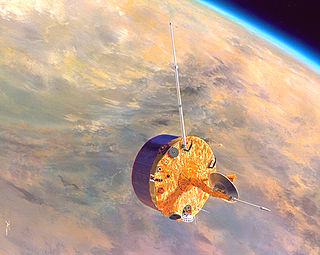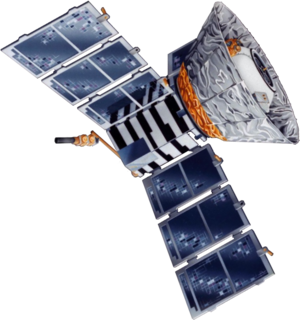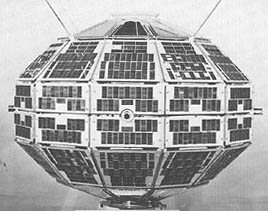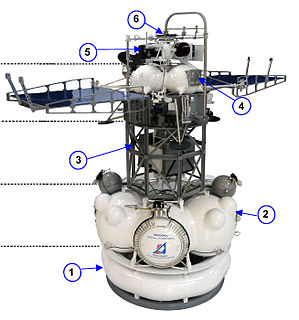Related Research Articles

Mariner 2, an American space probe to Venus, was the first robotic space probe to conduct a successful planetary encounter. The first successful spacecraft in the NASA Mariner program, it was a simplified version of the Block I spacecraft of the Ranger program and an exact copy of Mariner 1. The missions of the Mariner 1 and 2 spacecraft are sometimes known as the Mariner R missions. Original plans called for the probes to be launched on the Atlas-Centaur, but serious developmental problems with that vehicle forced a switch to the much smaller Agena B second stage. As such, the design of the Mariner R vehicles was greatly simplified. Far less instrumentation was carried than on the Soviet Venera probes of this period—for example, forgoing a TV camera—as the Atlas-Agena B had only half as much lift capacity as the Soviet 8K78 booster. The Mariner 2 spacecraft was launched from Cape Canaveral on August 27, 1962, and passed as close as 34,773 kilometers (21,607 mi) to Venus on December 14, 1962.

The Pioneer Venus Orbiter, also known as Pioneer Venus 1 or Pioneer 12, was a mission to Venus conducted by the United States as part of the Pioneer Venus project. Launched in May 1978 atop an Atlas-Centaur rocket, the spacecraft was inserted into an elliptical orbit around Venus on December 4, 1978. It returned data on Venus until October 1992.

The Pioneer Venus project was part of the Pioneer program consisting of two spacecraft, the Pioneer Venus Orbiter and the Pioneer Venus Multiprobe, launched to Venus in 1978. The program was managed by NASA's Ames Research Center.

The High-frequency Active Auroral Research Program (HAARP) was initiated as an ionospheric research program jointly funded by the U.S. Air Force, the U.S. Navy, the University of Alaska Fairbanks, and the Defense Advanced Research Projects Agency (DARPA). It was designed and built by BAE Advanced Technologies. Its original purpose was to analyze the ionosphere and investigate the potential for developing ionospheric enhancement technology for radio communications and surveillance. As a university-owned facility, HAARP is a high-power, high-frequency transmitter used for study of the ionosphere.

A geomagnetic storm is a temporary disturbance of the Earth's magnetosphere caused by a solar wind shock wave and/or cloud of magnetic field that interacts with the Earth's magnetic field.

The Cosmic Background Explorer, also referred to as Explorer 66, was a satellite dedicated to cosmology, which operated from 1989 to 1993. Its goals were to investigate the cosmic microwave background radiation (CMB) of the universe and provide measurements that would help shape our understanding of the cosmos.

Alouette 1 is a deactivated Canadian satellite that studied the ionosphere. Launched in 1962, it was Canada's first satellite, and the first satellite constructed by a country other than the Soviet Union or the United States. Canada was the fourth country to operate a satellite, as the British Ariel 1, constructed in the United States by NASA, preceded Alouette 1 by five months. The name "Alouette" came from the French for "skylark" and the French-Canadian folk song of the same name.

The Schumann resonances (SR) are a set of spectrum peaks in the extremely low frequency (ELF) portion of the Earth's electromagnetic field spectrum. Schumann resonances are global electromagnetic resonances, generated and excited by lightning discharges in the cavity formed by the Earth's surface and the ionosphere.

In astrophysics, a bow shock occurs when the magnetosphere of an astrophysical object interacts with the nearby flowing ambient plasma such as the solar wind. For Earth and other magnetized planets, it is the boundary at which the speed of the stellar wind abruptly drops as a result of its approach to the magnetopause. For stars, this boundary is typically the edge of the astrosphere, where the stellar wind meets the interstellar medium.

The Max Planck Institute for Solar System Research is a research institute in astronomy and astrophysics located in Göttingen, Germany, where it relocated in February 2014 from the nearby village of Lindau. The exploration of the solar system is the central theme for research done at this institute.

Space-based solar power (SBSP) is the concept of collecting solar power in outer space and distributing it to Earth. Potential advantages of collecting solar energy in space include a higher collection rate and a longer collection period due to the lack of a diffusing atmosphere, and the possibility of placing a solar collector in an orbiting location where there is no night. A considerable fraction of incoming solar energy (55–60%) is lost on its way through the Earth's atmosphere by the effects of reflection and absorption. Space-based solar power systems convert sunlight to microwaves outside the atmosphere, avoiding these losses and the downtime due to the Earth's rotation, but at great cost due to the expense of launching material into orbit. SBSP is considered a form of sustainable or green energy, renewable energy, and is occasionally considered among climate engineering proposals. It is attractive to those seeking large-scale solutions to anthropogenic climate change or fossil fuel depletion.

The Priroda module was the seventh and final module of the Mir Space Station. Its primary purpose was to conduct Earth resource experiments through remote sensing and to develop and verify remote sensing methods. The control system of Priroda was developed by the Khartron.
Satya Prakash is an Indian plasma physicist and a former senior professor at the Physical Research Laboratory. He is known for his studies on Langmuir probes and other contributions in space and plasma sciences. A protégé of Vikram Sarabhai, Satya Prakash is an elected fellow of all the three major Indian science academies such as Indian Academy of Sciences, Indian National Science Academy and National Academy of Sciences, India as well as the Gujarat Science Academy and is a recipient of the Hari Om Ashram Prerit Senior Scientist Award. The Government of India honored him with Padma Shri, the fourth highest Indian civilian award for his contributions to the discipline of Physics, in 1982.

The history of X-ray astronomy begins in the 1920s, with interest in short wave communications for the U.S. Navy. This was soon followed by extensive study of the earth's ionosphere. By 1927, interest in the detection of X-ray and ultraviolet (UV) radiation at high altitudes inspired researchers to launch Goddard's rockets into the upper atmosphere to support theoretical studies and data gathering. The first successful rocket flight equipped with instrumentation able to detect solar ultraviolet radiation occurred in 1946. X-ray solar studies began in 1949. By 1973 a solar instrument package orbited on Skylab providing significant solar data.

Space research is scientific study carried out in outer space, and by studying outer space. From the use of space technology to the observable universe, space research is a wide research field. Earth science, materials science, biology, medicine, and physics all apply to the space research environment. The term includes scientific payloads at any altitude from deep space to low Earth orbit, extended to include sounding rocket research in the upper atmosphere, and high-altitude balloons.

Yinghuo-1 was a Chinese Mars-exploration space probe, intended to be the first Chinese planetary space probe and the first Chinese spacecraft to orbit Mars. It was launched from Baikonur Cosmodrome, Kazakhstan, on 8 November 2011, along with the Russian Fobos-Grunt sample return spacecraft, which was intended to visit Mars' moon Phobos. The 115-kg (250-lb) Yinghuo-1 probe was intended by the CNSA to orbit Mars for about two years, studying the planet's surface, atmosphere, ionosphere and magnetic field. Shortly after launch, Fobos-Grunt was expected to perform two burns to depart Earth orbit bound for Mars. However, these burns did not take place, leaving both probes stranded in orbit. On 17 November 2011, Chinese state media reported that Yinghuo-1 had been declared lost by the CNSA. After a period of orbital decay, Yinghuo-1 and Fobos-Grunt underwent destructive re-entry on 15 January 2012, finally disintegrating over the Pacific Ocean.
The Atmospheric dynamo is a pattern of electrical currents that are set up in the Earth's ionosphere by multiple effects, mostly the Sun's solar wind, but also the tides of the Moon and Sun. The currents flow in circuits between the poles and the equator, but they are not well understood.

Robert Eugene Bourdeau was an American physicist known for major contributions to the study of the ionosphere, plasma physics and radio science using space vehicles including satellites and rockets. Among his many achievements was the launch on November 3, 1960 of Explorer 8 from Cape Canaveral, Florida. This occurred during his 16-year career at the National Aeronautics and Space Administration (NASA). He was both Project Manager and Project Scientist for Explorer 8 which added significant knowledge to the understanding of these fields.

Explorer 27 was a satellite, launched in 1965, designed to conduct scientific research in the ionosphere. It was powered by 4 solar panels. One goal of the mission was to study in detail the shape of the Earth by way of investigating variations in its gravitational field. It was the third and last of the Beacons in the Explorers program. The satellite was shut off in 1973 so that its transmission band could be used by higher-priority spacecraft.
References
- ↑ Kaya, N.; Matsumoto, H.; Miyatake, S.; Kimura, I.; Nagatomo, M. (1986). "Nonlinear interaction of strong microwave beam with the ionosphere MINIX rocket experiment". Space Solar Power Review. 6 (3): 181–6. Bibcode:1986iece.conf..181K. OCLC 4434489765. OSTI 6955190.
- ↑ Nagatomo, Makoto; Kaya, Nobuyuki; Matsumoto, Hiroshi (January 1986). "Engineering aspect of the microwave ionosphere nonlinear interaction experiment (MINIX) with a sounding rocket". Acta Astronautica. 13 (1): 23–9. Bibcode:1986AcAau..13...23N. doi:10.1016/0094-5765(86)90004-4.